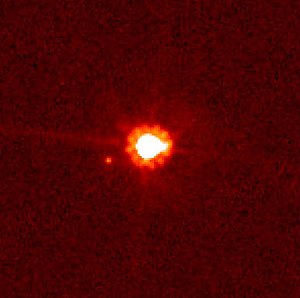Our website is made possible by displaying online advertisements to our visitors.
Please consider supporting us by disabling your ad blocker.
Scattered disc

|
The scattered disc (or scattered disk) is a distant circumstellar disc in the Solar System that is sparsely populated by icy small Solar System bodies, which are a subset of the broader family of trans-Neptunian objects. The scattered-disc objects (SDOs) have orbital eccentricities ranging as high as 0.8, inclinations as high as 40°, and perihelia greater than 30 astronomical units (4.5×109 km; 2.8×109 mi). These extreme orbits are thought to be the result of gravitational "scattering" by the gas giants, and the objects continue to be subject to perturbation by the planet Neptune.
Although the closest scattered-disc objects approach the Sun at about 30–35 AU, their orbits can extend well beyond 100 AU. This makes scattered disc objects among the coldest and most distant objects in the Solar System.[1] The innermost portion of the scattered disc overlaps with a torus-shaped region of orbiting objects traditionally called the Kuiper belt,[2] but its outer limits reach much farther away from the Sun and farther above and below the ecliptic than the Kuiper belt proper.[a]
Because of its unstable nature, astronomers now consider the scattered disc to be the place of origin for most periodic comets in the Solar System, with the centaurs, a population of icy bodies between Jupiter and Neptune, being the intermediate stage in an object's migration from the disc to the inner Solar System.[4] Eventually, perturbations from the giant planets send such objects towards the Sun, transforming them into periodic comets. Many objects of the proposed Oort cloud are also thought to have originated in the scattered disc. Detached objects are not sharply distinct from scattered disc objects, and some such as Sedna have sometimes been considered to be included in this group.
- ^ Masetti, Maggie (2007). "Cosmic Distance Scales – The Solar System". Website of NASA's High Energy Astrophysics Science Archive Research Center. Retrieved 2008-07-12.
- ^ Cite error: The named reference
Morbidelli2008was invoked but never defined (see the help page). - ^ Weissman, Paul R.; McFadden, Lucy-Ann; Johnson, Torrence V., eds. (1999). Encyclopedia of the solar system. San Diego: Academic Press. pp. 584 (footnote). ISBN 978-0-12-226805-2.
- ^ Horner, J.; Evans, N. W.; Bailey, M. E. (2004). "Simulations of the population of Centaurs - I. The bulk statistics". Monthly Notices of the Royal Astronomical Society. 354 (3): 798–810. arXiv:astro-ph/0407400. Bibcode:2004MNRAS.354..798H. doi:10.1111/j.1365-2966.2004.08240.x. S2CID 16002759.
Cite error: There are <ref group=lower-alpha> tags or {{efn}} templates on this page, but the references will not show without a {{reflist|group=lower-alpha}} template or {{notelist}} template (see the help page).
Previous Page Next Page


